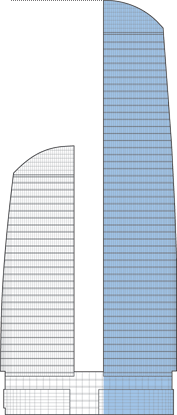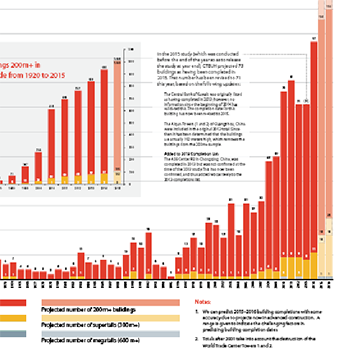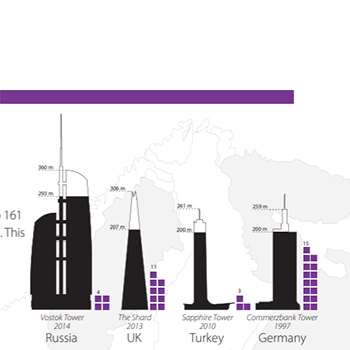Filter by
You must be a CTBUH Member to view this resource.

Federation Tower
Башня Федерации, Federation Towers - Vostok Tower
Building
Completed
2016
Residential / Office
All-Concrete
373.7 m / 1,226 ft
93
4
63
67
7 m/s
You must be a CTBUH Member to view this resource.
You must be a CTBUH Member to view this resource.
The Engineer of Record takes the balance of the engineering effort not executed by the “Design Engineer,” typically responsible for construction documents, conforming to local codes, etc.
The CTBUH lists a project manager when a specific firm has been commissioned to oversee this aspect of a tall building’s design/construction. When the project management efforts are handled by the developer, main contract, or architect, this field will be omitted.
The main contractor is the supervisory contractor of all construction work on a project, management of sub-contractors and vendors, etc. May be referred to as "Construction Manager," however, for consistency CTBUH uses the term "Main Contractor" exclusively.
Other Consultant refers to other organizations which provided significant consultation services for a building project (e.g. wind consultants, environmental consultants, fire and life safety consultants, etc).
Material Supplier refers to organizations which supplied significant systems/materials for a building project (e.g. elevator suppliers, facade suppliers, etc).
You must be a CTBUH Member to view this resource.
Usually involved in the front end design, with a "typical" condition being that of a leadership role through either Schematic Design or Design Development, and then a monitoring role through the CD and CA phases.
Usually takes on the balance of the architectural effort not executed by the "Design Architect," typically responsible for the construction documents, conforming to local codes, etc. May often be referred to as "Executive," "Associate," or "Local" Architect, however, for consistency CTBUH uses the term "Architect of Record" exclusively.
The Engineer of Record takes the balance of the engineering effort not executed by the “Design Engineer,” typically responsible for construction documents, conforming to local codes, etc.
The Design Engineer is usually involved in the front end design, typically taking the leadership role in the Schematic Design and Design Development, and then a monitoring role through the CD and CA phases.
The CTBUH lists a project manager when a specific firm has been commissioned to oversee this aspect of a tall building’s design/construction. When the project management efforts are handled by the developer, main contract, or architect, this field will be omitted.
The main contractor is the supervisory contractor of all construction work on a project, management of sub-contractors and vendors, etc. May be referred to as "Construction Manager," however, for consistency CTBUH uses the term "Main Contractor" exclusively.
Other Consultant refers to other organizations which provided significant consultation services for a building project (e.g. wind consultants, environmental consultants, fire and life safety consultants, etc).
These are firms that consult on the design of a building's façade. May often be referred to as "Cladding," "Envelope," "Exterior Wall," or "Curtain Wall" Consultant, however, for consistency CTBUH uses the term "Façade Consultant" exclusively.
Material Supplier refers to organizations which supplied significant systems/materials for a building project (e.g. elevator suppliers, facade suppliers, etc).
17 January 2018 - CTBUH News
13 October 2016 - CTBUH Research
.jpg)
10 January 2017
Jason Gabel, Annan Shehadi, Shawn Ursini & Marshall Gerometta, CTBUH
CTBUH has determined that 128 buildings of 200 meters’ height or greater were completed around the world in 2016 – setting a new record for...
Federation Tower is designed as part of a larger complex, Federation Towers, rises along with the shorter Zapad Tower from a shared nine-story podium. The two buildings mirror each other in design, with softly sloping exteriors that narrow as they rise, though Vostok Tower is 131 meters taller than its counterpart. The towers form two rounded equilateral triangles in plan with sides that bow outward. A 506-meter spire was originally planned to rise out of the podium in the center of the complex, but was dismantled in 2015 after it had been partially constructed.
The building utilizes a concrete core and is the first in Russia to utilize super high-strength, high-performance concrete. In addition, three levels of steel outrigger truss systems work to strengthen the building by distributing gravity and wind loads between the core and perimeter framing. The tower has a straightforward façade; a hanging glass curtain wall provides the main external ornamentation for the structure. Horizontal stripes delineating the building’s individual floors work to augment the building’s perceived girth. The rotund configuration of the tower is underplayed by the podium, which meets the street with a rectilinear extension that caters to the human scale for pedestrians. Like many buildings of this size, underground linkages enhance how the building connects with the surrounding urban environment. Several levels below ground, the complex ties in with the Moscow Metro and a large shopping center. Eventually, all of Moscow City is to be connected below grade, creating a truly “underground city.”
.jpg)
10 January 2017
Jason Gabel, Annan Shehadi, Shawn Ursini & Marshall Gerometta, CTBUH
CTBUH has determined that 128 buildings of 200 meters’ height or greater were completed around the world in 2016 – setting a new record for...

31 December 2014
Daniel Safarik, Antony Wood, Marty Carver & Marshall Gerometta, CTBUH
An All-Time Record 97 Buildings of 200 Meters or Higher Completed in 2014 and 2014 showed further shifts towards Asia, and also surprising developments in...

01 June 2013
CTBUH Research
There are currently 109 skyscrapers over 150 meters in Europe. This number is set to jump to 161 by the end of 2015, meaning that...
17 January 2018
Check out all of our 2018 Tall Building Predictions, and dive into the full 2017 Tall Building Year in Review data report.
13 October 2016
The Council is pleased to announce the Top Company Rankings for numerous disciplines as derived from the list of projects appearing in 100 of the World’s Tallest Buildings.
Subscribe below to receive periodic updates from CTBUH on the latest Tall Building and Urban news and CTBUH initiatives, including our monthly newsletter. Fields with a red asterisk (*) next to them are required.
View our privacy policy